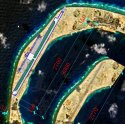Blackstone...I am intentionally not going into the details of what will ultimately be a political debate.
SD is not a political forum.
This thread is not a place for a US political debate about it.
Now, in the world/public, that debate is going to happen...my guess is aspects of it will occur in the run up to the 2016 election.
But SD is not the place for it.
FON and its application is something that should not be political. It is what it is.
Improving your own holding in the SCS as China is doing is not something that should be political either. it is what it is and is very straight forward.
Neither of those has to tell on primacy. China can improve it holdings and positions in the SCS without the US being pushed out of the picture. The US can conduct straight forward FON without pushing China back into any kind of bottle.
As I have said over and over, as long as that happens (on both sides) there is no need for, and IMHO will not be any, conflict over it.
Some politicians and fire brands (on both sides) may want to push it to that level of confrontation...but my whole point is that it does not need to.
Finally....
This thread is also not a strategy thread. These discussions are about strategies and policies.
This thread is supposed to be about the SCS Islands and Bases for China and how they are improving them.
Take strategy to either the Chinese Strategy thread, or the SCS Other Nation Strategy Page.
Any more strategy oriented discussion here will be deleted.
DO NOT RESPOND TO THE MODERATION.
SD is not a political forum.
This thread is not a place for a US political debate about it.
Now, in the world/public, that debate is going to happen...my guess is aspects of it will occur in the run up to the 2016 election.
But SD is not the place for it.
FON and its application is something that should not be political. It is what it is.
Improving your own holding in the SCS as China is doing is not something that should be political either. it is what it is and is very straight forward.
Neither of those has to tell on primacy. China can improve it holdings and positions in the SCS without the US being pushed out of the picture. The US can conduct straight forward FON without pushing China back into any kind of bottle.
As I have said over and over, as long as that happens (on both sides) there is no need for, and IMHO will not be any, conflict over it.
Some politicians and fire brands (on both sides) may want to push it to that level of confrontation...but my whole point is that it does not need to.
Finally....
This thread is also not a strategy thread. These discussions are about strategies and policies.
This thread is supposed to be about the SCS Islands and Bases for China and how they are improving them.
Take strategy to either the Chinese Strategy thread, or the SCS Other Nation Strategy Page.
Any more strategy oriented discussion here will be deleted.
DO NOT RESPOND TO THE MODERATION.
Last edited:








